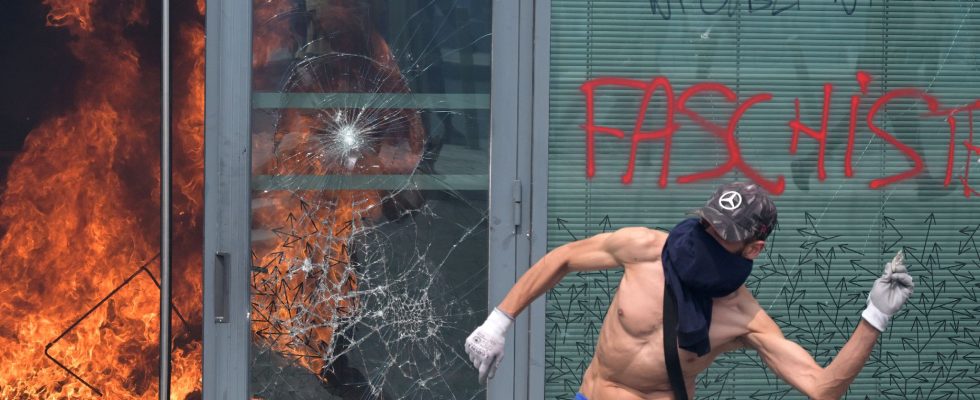As anger and nightly clashes between police and young people from working-class neighborhoods, often from minorities, escalate and now spread beyond Ile-de-France – after the death of young Nahel killed by a policeman during a filmed traffic check, Tuesday June 27 – the foreign press seeks to understand and analyze the poisoned relations between the police and the young people of the districts.
Nahel’s death “presents a new challenge for Macron”, thus title the New York Times, whose Paris bureau chief Roger Cohen and his reporters have been covering rising tensions in detail since Tuesday. Describing a “delicate balancing act” for Emmanuel Macron, after the long episode of troubles linked to the pension reform, the American journalist thus points to the duality of the words of the president, a specialist in “at the same time”, who “has to first described the point-blank shooting of the police officer as ‘inexcusable’ and ‘inexplicable’, before condemning the violent demonstrations as absolutely unjustifiable”.
In a June 28 article, the belgian newspaper The evening notes meanwhile that “the executive has taken out all its water lances” to “extinguish the fire as quickly as possible before it spreads – to try, at least”, while the highest officials – from Emmanuel Macron to Elisabeth Borne, and even Gérald Darmanin – are on the bridge to call for calm. “The Minister of the Interior, usually quick to defend his men, is on the contrary clearly dissociated”, also points out the correspondent of the newspaper Joëlle Meskenswhile the New York Times also note the “unusually critical” attitude of the minister openly close to the police unions.
Americanization of the French police?
In a statistical study published last Septemberresearchers Sébastien Roché, Paul le Derff and Simon Varaine have demonstrated that fatal police shootings at moving vehicles increased fivefold between before and after the passing of a 2017 law that relaxed the use of firearms. fired by the police.
“Nahel’s death has drawn accusations from the left that the French police have been ‘Americanized’,” he added. New York Times, “even as the right has focused on the growing violence of protesters towards an embattled police force”. The rapprochement with American police violence is not new. “A report broadcast recently on television by journalists covering the interventions of the police against environmental demonstrators in Sainte-Soline at the end of March made an impression. The police there give the impression of going to war. Two demonstrators were seriously injured, and it is a miracle that there were no fatalities”, raises the German daily Suddeutsche Zeitungwhich asks the question: “When will the French police change?”
In addition to an increase in violence, “what makes things more difficult today is that, unlike the riots of 2005, a video is circulating and leaves little room for doubt”, points out Austrian daily correspondent The Standard. “In the French suburbs, its emotional impact is as great as the video of the death of George Floyd, which led to the Black Lives Matter movement in the United States in 2020”, notes the Austrian journalist. The comparison with the murder of the American George Floyd by a police officer in 2020 in Minneapolis (Minnesota), also partly proven by a video shot from a mobile phone, comes up regularly in the foreign press. “This blunder could be the French George Floyd affair”, squarely judges the German weekly Die Zeit.
Athena and “Civil War”
For the third night in a row, violence broke out in many popular French neighborhoods on Thursday evening June 29. Garbage cans, cars and sometimes burnt buildings, firework rockets and molotov cocktails thrown in the direction of the police and scuffles… The anger does not subside, once again driving certain media like the second Italian daily La Repubblica to describe the French situation as “guerrilla”. About 40,000 police officers, a helicopter and special riot control services were deployed by the Interior Ministry on French territory last night, and 875 arrests were carried out. “In the movie Athena, presented at the Venice festival, Romain Gavras had imagined how the murder of a little boy from the suburbs by the police could plunge France into civil war”, also recalls the Italian newspaper. “A film at the center of controversy, accused of proposing an apocalyptic vision. It’s impossible not to think about this ultra-violent western tale right now,” he said.
How to get out of this tense situation and appease popular anger? Despite a desire to “restore calm”, according to the New York Times“if the measures that Emmanuel Macron is taking to stop the riots are too drastic, they can only fuel anger against police violence perceived as directed disproportionately against immigrants of Arab origin or black people”, points out the newspaper .
Night curfews have already been decreed in Clamart and Meudon (Hauts-de-Seine), Neuilly-sur-Marne (Seine-Saint-Denis) and Compiègne (Oise) on Thursday June 29. “In 2005, the death of two young people pursued by the police in Clichy had provoked 21 consecutive days of violence and clashes, forcing the right-wing government to approve a curfew” in many large cities in the Paris region but also in outside as in Nice, Orléans, Le Havre or Rouen, reminds La Repubblica. While “France is bubbling”, “it is an extreme measure which is no longer to be excluded”, notes the newspaper. For the time being, “the state of emergency, demanded by the leader of the right Eric Ciotti and by the far right” has been “dismissed”, remember The eveningwho nevertheless judges that “all the ingredients are there to blow up the pressure cooker”.
